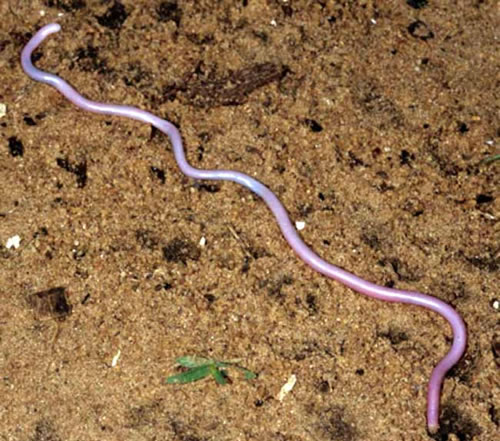A rare blind snake has been rediscovered in Madagascar a century after its last sighting. The snake, which looks like a long, skinny pink worm, was only known from two other specimens, both discovered in 1905.
"They're really rare because they're subterranean," said blind-snake expert Van Wallach of Harvard University who described the new specimen. "You can't just go out anytime you want and collect these things. You can dig forever and never find them."
Scientists captured the snake, called Xenotyphlops mocquardi, alive in 2005 during an expedition to collect reptiles and amphibians in northern Madagascar. The specimen was approximately 10 inches long and about as thick as a pencil.
There are about 15 species of blind snakes on the island, so the unique nature of the team's find wasn't apparent until the blind snake specimen was sent to museum experts for identification and possible comparison with dead specimens in their collections.
There are approximately 15 species of blind snakes on Madagascar. Blind snakes detect their prey using a sharp sense of smell, which they detect using their tongues and an organ located on the roof of their mouth, called the Jacobsen's organ. They live on the eggs and pupae of ants and termites, and are the only snakes that subsitst entirely on insects.
Blind snakes, and a related group, called worm snakes, live underground or beneath a layer of rocks or sand. They can perceive light because they are negatively phototaxic, meaning they avoid light whenever possible.
"Most blind snakes and worm snakes do have eyes, but they're vestigial," Wallach said. "Sometimes they're only little black spots, sometimes they're well developed enough to have a pupil and an iris, but they're very, very tiny."
Cited story and image.
.


Mine's bigger...
Cool! I hadn't heard this. Thanks for including interesting herp scientific news. It's also timely for me--I've been thinking lately about how nocturnality might have evolved (and the underlying genetic changes therein), and as a corollary, wondering what the circadian rhythm is like of fossorial (burrowing) species such as the blind snakes.
are people allowed to own these as pets? i love snakes and have heard of this kind alot recently. i dont know why. I also think thier kind of cute and they look friendly. get back to me on this please,
thanks, whit-lynn